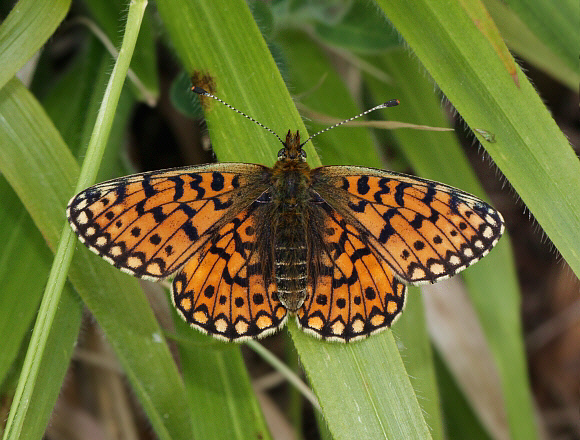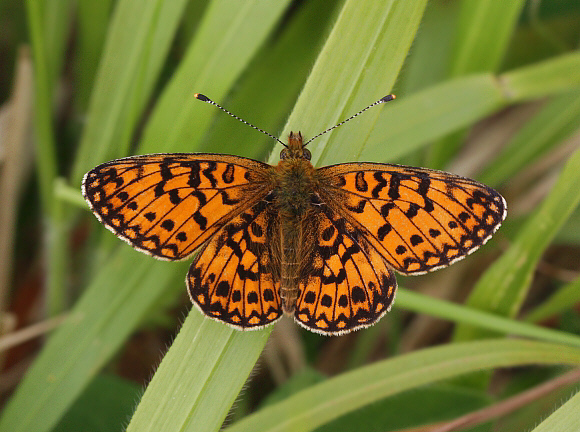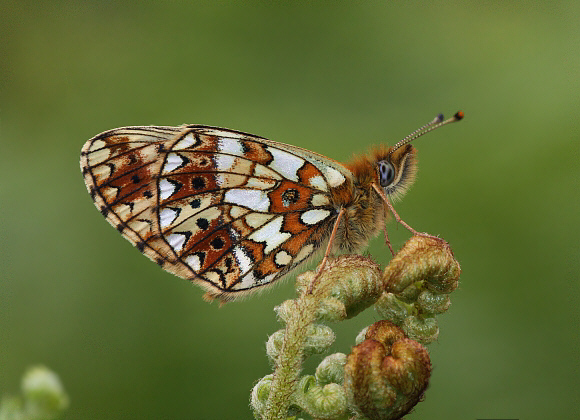
Small Pearl-bordered Fritillary Clossiana selene, male at roost – Adrian Hoskins
Introduction
This species is distributed throughout northern Europe, but is absent from Ireland, the southern half of the Iberian peninsula, Italy, Greece and the Mediterranean islands. It is found in temperate Asia as far east as Mongolia and Korea; and in North America.
It often shares it’s habitats with the very similar Pearl-bordered Fritillary, which flies a week or two earlier in the season. The flight periods of the 2 species overlap, so worn specimens of euphrosyne can often be seen in the company of fresh specimens of selene.
The latter is easily distinguished by examining the undersides, which have additional silver spots in the median area, and distinct black chevrons on the inner edge of the silvery submarginal lunules. The uppersides of selene have darker veins and more linear markings than euphrosyne.

Small Pearl-bordered Fritillary Clossiana selene, female – Adrian Hoskins
Habitats
In England this species breeds primarily in sheltered, sunny and damp woodland clearings, often in the vicinity of irrigation ditches or small streams beside which it’s larval foodplants – common dog violet and marsh violet – grow lush and in profusion. In Cornwall the butterfly is found along cliff tops. The butterfly is very sedentary in behaviour, forming small discrete colonies often comprising less than 20 adults at peak flight season, although populations can be as large as 100 adults at the best sites.
In Scotland and Wales it breeds in woodland clearings, and also in more open habitats on moors, heaths and rough grassland, usually in wet areas close to lakes, lochs or mountain streams. There the butterfly is much more widespread, and can be found at low densities over extensive areas.
In Europe the butterfly occurs commonly in damp meadows, moist heathland, and on mountainsides in the Alps, Pyrenees and Massif Central.
Lifecycle
The Small Pearl-bordered Fritillary is single brooded in the northern part of it’s range, but produces a partial or complete 2nd brood in warmer areas in the south. The 1st brood emerges in June, and the 2nd ( where and when it occurs ) emerges in August.
The straw coloured eggs are laid singly in early June ( and again in August if there is a 2nd brood )on the leaves and stems of violets or nearby herbaceous plants. Often the eggs are dropped quite randomly as the female flutters about, edging her way through the vegetation.
The larvae hatch after about 12 days, and eat their egg-shells before wandering in search of violet leaves. They feed diurnally on the leaf lobes of Viola palustris or V. riviniana. In September, when in the 3rd or early 4th instar, they enter hibernation within a dead curled up leaf. They awaken the following March to resume feeding, becoming fully grown by late April. The presence of the larvae, which are dark brown with distinctive orange spikes, is given away by semi-circular nibble marks left on the edges of violet leaves.
Pupation takes place amongst low vegetation. The chrysalis is dark brown, with paler wing cases, marked with darker streaks, and has small silvery spots on the thorax.

Small Pearl-bordered Fritillary Clossiana selene, male, Wiltshire – Adrian Hoskins
Adult behaviour
Early on sunny mornings the butterflies spend long periods basking on bracken. By about 9.00 am they are fully active, and can be seen nectaring at wood spurge, ragged robin, thistles, and less frequently at tormentil, bugle or heather.
The very similar Pearl-bordered Fritillary which often flies in company with this species, nectars almost exclusively at bugle and dandelion – a useful identification point.
In the late mornings the males patrol back and forth across the breeding sites, flying low over the ground in search of females. I have not observed any courtship behaviour, and it is likely that copulation occurs almost immediately when the sexes meet. Mated pairs can sometimes be found at rest on low herbage. Copulation lasts for about 2 hours during which time the pair may both bask with wings outspread if the temperature drops.
The butterflies roost overnight on bracken fronds, dead flower-heads of St Johns wort, or on the flowers of rushes or pendulous sedge, in sheltered glades.
 Small Pearl-bordered Fritillary Clossiana selene, at roost on bracken frond – Adrian Hoskins
Small Pearl-bordered Fritillary Clossiana selene, at roost on bracken frond – Adrian Hoskins
